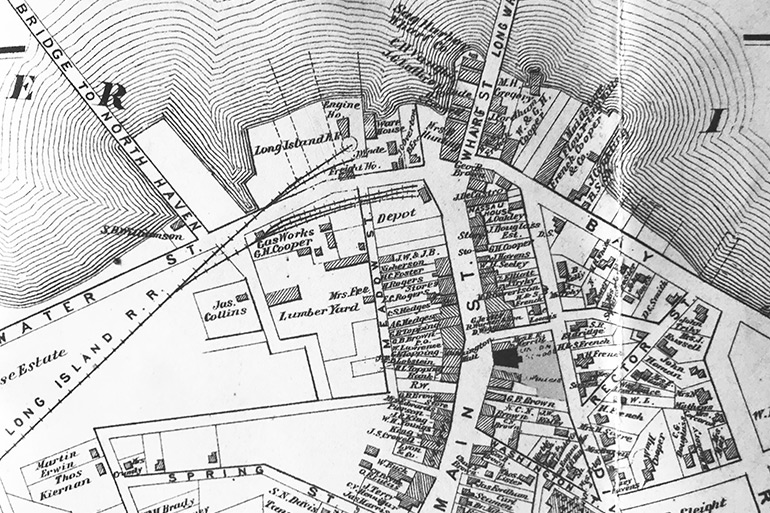Sag Harbor Secrets: Two Old Maps, One from 1840, the Other from 1880

Just before the bulldozers came in and tore up the two abandoned buildings facing out onto what will now be the beautiful arc of beach of the upcoming Steinbeck Waterfront Park in Sag Harbor, I took a walk through the brambles and bushes of that place one last time. One building was an abandoned two-story wood-shingled former office building with broken windows built in the 1970s that somehow got caught up in a real estate squabble that resulted in it not having access to Main Street.
The other abandoned building was a puzzle. It was a one-story rectangular stone building right on the west end of what now will be the curving beach. There were rectangular holes where windows must have been. There was a large entry doorframe, but vines and creatures now made it home.
I didn’t think this of any particular interest when I first saw it. But then I noticed the remains of a concrete road leading to it. This was all broken up and covered with weeds. On an old 1840 map it was called Ferry Road. Walking this road going east away from this building got you nowhere. It ended buried in the grassy side of the North Haven Bridge just about where the western abutment is now.
But on the old map it did not end buried in the abutment of a bridge. There had been no bridge yet. Instead, this broken-down road continued down to Long Wharf and then on as Division Street and ultimately all the way to East Hampton. Indeed, on this old map Ferry Road was also noted as Route 114. This is where Route 114, which begins at Town Pond in East Hampton and heads to Sag Harbor, would find its dead end at the ferry to North Haven.
Thus, I believed, the building I was looking at was the ferry building waiting room for the ferry to North Haven. It would come in from North Haven. People would meet it there with wagons or coaches, to go off with those getting off. Then others would get on to go to North Haven.
Anyway, it’s now all torn out and razed. Nothing further there to consider. Probably just a piece of unimportant history from a long time ago when only ferries took people back and forth between North Haven and Sag Harbor.
This scene, however, has stuck in my mind, because there was one thing wrong with it. The old abandoned Ferry Road, broken up as it was, was paved. They didn’t have paved roads in the 18th or 19th century. This old ferry dock, if that is what it was, was active until recently.
Could it be there had been a bridge, rather than a ferry, to North Haven alongside this building? This is well west of where the bridge is now. If there was one, it didn’t create the problem of arriving into the grand melée that is where all the roads (plus the new bridge) come together now. It would have arrived approximately where the Post Office is today, on what is now called West Water Street. It would have given you the option to bypass Sag Harbor Village if you wanted to. Just turn right and go behind downtown.
Talking to the Sag Harbor Historical Society people and some people familiar with the history of Sag Harbor, I learned that the first bridge connecting Sag Harbor to North Haven was built in 1799. It is in the minutes of a Village meeting. So-and-so wants permission to build a wooden bridge between these two entities because he wants to build a mill on North Haven and needs such a bridge to bring over building materials.
There are notes in 1840 about building a bridge. How long the bridges lasted, we do not know. The broken paved road must have been a dirt track back then, and maybe that’s when the ferry worked for when the wooden bridge was out.
Recently, I found a newer map showing where a wooden bridge between these two shores came down in Sag Harbor. It also came down where I now believed it would, not at Long Wharf, but where the post office is. I was having lunch at Baron’s Cove in their second-floor dining room that overlooks the arc of what is soon to be Steinbeck Waterfront Park. Beneath my plate was a paper placemat with a map of Sag Harbor made around 1880. I publish it as the illustration to this story. And there it is, the bridge to North Haven, right where the post office is today.
In 1932, the U.S. government built a very serious concrete bridge between Sag Harbor and North Haven. It was part of a government works project, WPA, to give people work during the Depression. There weren’t a whole lot of automobiles back in 1932. There were no endless traffic jams. And that 1932 bridge came down on the Sag Harbor side not where the post office is now, but right into the center of the melée in the center of town. Maybe it made sense in 1932. It doesn’t now. Traffic on the bridge often backs up coming into the melée.
In 1998, the state declared this bridge too shaky for cars. A new bridge would have to be built. When planning for it, people urged that it be built in the style of the 1932 bridge, with the decorative lighting stanchions and railings. And that was agreed to. But when the feds said it should be placed somewhere else so as not go right into the melée—perhaps where the earlier bridge came in—the village batted that idea down. This may have been a mistake, in my opinion.
Well, what’s done is done. And yes, I have quite gotten myself off-track here. I had been writing about what I thought was a ferryboat building.
So was that concrete ruin a ferry building? People have told me that in the 1950s and 1960s it was a fishing station owned by some people called Raynor. That explains the concrete road. Before that though, during the era of wooden bridges, it might have been the ferry building. We are talking layers and layers of history here.
And, look really closely at that old map near to where the Post Office is today. You will see railroad tracks. A spur had been built in 1895 that went from Bridgehampton to Sag Harbor, dead-ending just to the west of Long Wharf. In 1939, it was abandoned as no longer profitable. And in 1942, all the railroad tracks were hauled off to be used to make ships and aircraft to fight World War II. Here on this map, you see five or six railroad tracks at the dead end—a railroad yard.
Thank goodness that railroad yard and the railroad line from Bridgehampton is gone. It is making way for—ta da!—the Steinbeck Waterfront Park. This brand new and absolutely beautiful waterfront open area with trees and grass and a lovely curving beach from which you can watch the sun set over the boats is being built on a former railroad yard!

Here’s more news about downtown Sag Harbor. This spring, dredges came in to deepen the water surrounding Long Wharf. If we’re gonna have 230-foot yachts here, we have to give them the necessary draft space underwater.
The “spoil,” as it was called, was put on a barge and taken over to Haven’s Beach, about a half-mile down Bay Street. And guess what? In this spoil, people with metal detectors have found cannon balls. Some may have been used in the War of 1812, when there was a battle there. They’ve found kitchen utensils and plates and cups.
RELATED: Dredging Up Sag Harbor’s Treasured Past on Havens Beach
One plate was an expensive proposition that must have been made in Britain in the early 1800s—the equipment to make plates this way had not yet arrived in America—and has the engraving of the Great Seal of the United States of America on it. Imagine that—a country that just lost the war that created America getting the job to make a plate with that new country’s national seal.
Well, it fell off the boat as it arrived.


